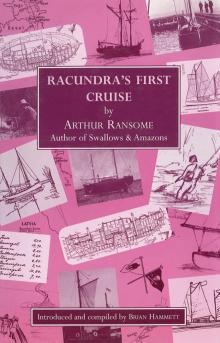- Home
- Arthur Ransome
Racundra's First Cruise Page 2
Racundra's First Cruise Read online
Page 2
From Cape Ninamaa, we took a course west southwest, hoping to pick up the Pakerort lighthouse about thirteen miles away. But the wind fell almost to nothing. It grew dark. At midnight, sailing, or rather drifting, only for a second or two at a time having any way on the boat, we learnt where we were, when the Pakerort lighthouse glittered out, and finding ourselves on a direct line between it and the Surop, we knew that we were not out of our course. To get home, we had only to round Cape Lohusaar into Lahepe Bay. But once before, fishing for sea-devils, I had been to the mouth of that bay, and knew that isolated rocks run out from Cape Lohusaar a considerable way into the sea. If there had been much wind, we should have run on close to the Pakerort, and then turned back on a southeast slant into the bay, which would have been safe enough. As it was there was not enough wind even to give one control over the boat, so there was nothing to do but to wait till dawn. It was a jolly dawn over the Baltic Sea and, as it lightened, we recognised Lohusaar Cape, only a mile or two before us, and with a slight wind from the southeast sailed past the rocks, which stood out even further than I had remembered across the bay. And then bearing up to the wind which was veering east southeast, cut into and across the bay. It was two in the morning when we were into the bay, and if the wind had held we should have been home to breakfast; but it fell away altogether. We made one interminable tack east northeast and anchored in an almost dead calm, bathed, made a tent out of the mainsail, and fell asleep like logs.
At eleven we woke, and found just enough wind to take us home to the southeast corner of the bay; where, after stripping, and towing her through the narrow channels in the sand banks, we anchored in shallow water, and came ashore, after having had a very good all round specimen of Baltic weather, and gained a very considerable confidence in “The Slug”, besides a little in ourselves.
(Autobiography) It was a ridiculous beginning, to take an open boat for sixty miles of sailing, mostly tacking, along a coast we did not know, but it was not more ridiculous than some of our later experiments. Evgenia had never been in a sailing boat before, and I owe it alike to her ignorance and her courage that this first voyage did not in any way deter her from other adventures. We have never since been without some sort of boat, and for a number of years worked very hard to make ourselves reasonably efficient, taking every chance of sailing in vessels of every kind as well as in our own.
Two days after this eventful first trip Ransome drafted a letter to his old friend Barbara Collingwood (daughter of W.G. Collingwood), with whom he had been in love in his youth. The letter appears not to have been finished or ever sent. It does show, however, that Ransome was at an early stage in developing his sailing skills.
C/O British Consulate,
Reval.
July 5, 1920.
My dear Barbara,
First voyage satisfactorily accomplished. I enclose with this a copy of the Log. The bit with the storm was exciting but short. If it had lasted longer, perhaps we should not have fared so well. As it was it greatly increased the belief I had in the boat and in myself, which, at the beginning, was extremely small. Before starting, we had to get a passport for the boat. They made me put E.P. down as “sailor”. When we were starting, and leaving the pier to which we were tied up, she took an oar and backwatered instead of rowing by mistake, whereupon the scoundrel who sold us the boat remarked with a grin, “Your sailor does not know how to row”. He had already in most uncomplimentary terms expressed his opinion of my own seamanship. I had to work entirely on what I remembered of Robin’s instructions. But one thing he never taught me, and that was how to heave to in a wind and keep more or less in one place without handling the sails. I know the thing is done by fixing the sails and the tiller someway or other, but no amount of rule of thumb experiment arrived at the desired result. I shall be much obliged for detailed instructions, if possible with diagram on this point.
The rig of the boat is not quite the same as Swallow or Jamrach’s. The gaff? (the stick at the top of the mainsail) projected in front of the mast. The boom is as per Swallow. There is also a triangular foresail (?) jib, called hereabouts the cleaver.
That is something like. She is I think 18 feet long. She was built about a hundred years ago, but she practically does not leak at all.
All her rigging is rotten. Ditto her sails, which are made of something suspiciously like old sheets. We’ve spent the day in repairs. In the course of the repairs arose about five hundred technical questions for Robin or Ernest, and neither of these Nesters are on hand. I have with trepidation but apparent success taken out the rope that howks the main sail up, and put it back t’other end on, because it had a knot at one place, which made it impossible to lower it altogether. Further I have developed what seems to me to be rather a shady trick of tying the low corner of the mainsail to the thwart beside the mast. Nothing else to tie it to. A screw with a ring to it probably meant for that purpose came out bodily, suggesting rottenness in the mast, which, for peace of mind, I have to refrain from investigating. E. has patched the mainsail with tablecloth, and talks of grey paint. She says she prefers boats to fishing, and has already learnt to sail the Slug in a calm. I think that unless some accident puts an end to our experiments, another month of Baltic cruising on a minute scale should bring us on a long way in the practical part of the business. But I fairly yearn for Robin, and curse every few minutes the many hours of possible sailing I missed at Coniston. I ought to have tied myself to Swallow, and slept on her, and gone out with her whenever Robin descended from on high to make her perform her mysteries. Then I should know a little more about it. I think I had better number every sentence in this letter, and beg for an expert commentary on each. It’s the little things that I don’t know, how on earth does one make a perfect circle of rope with no knot to fasten round (1) a hollow iron ring and (2) a pulley, by whipping it in the middle? How does one find except by a hundred very wearisome experiments how and where to fasten the rope that howks up the mainsail to the infernally awkward bit of stick that goes across the top of the same instead of ending with jaws round it like the similar stick in good old Swallow?
The Baltic, I may say, has one great advantage over our own in that there is no tide. So if you hit a sandbank with your keel once, you can be sure of hitting it again at any hour of the day. Rocks do not play bo-peep with you. There are hundreds and thousands of them but where they are there they remain, and the wise sailor takes off his hat to them as he passes.
I have got a pretty good German chart of 1908, showing the whole of the gulf of Finland, from Hango in Finland, and the island of Worms (Esthonian) right up to Petrograd, on a scale of what I make out to be about 6¼ miles to the inch. It gives inset charts of the approaches to the principal harbours, on a scale little more than twice as big. It has little miniature pictures of all the lighthouses, so that you can recognise them by day. Enormous fun. I have now made the acquaintance of four of them.
The awful thing about open boat cruising is that one gets absolutely no rest. There is no cabin, no means of sleeping out of the sun, and for grub one has either to land, an unwelcome and risky operation, or else do without a fire and exist on sandwiches. I have absolutely made up my mind to get a boat for single-handed sailing with a cabin, and with everything thought out wilily to make her working easy. Ratchet reefing for example. Everything fixed for comfort so that one could really live on board, which in an open boat like the Slug is impossible. On our thirty-six hour trip, I had only four hours of v. uncomfortable sleep in the bottom of the boat, while at anchor.
Now please, if possible, get answers to some of the questions in this letter... particularly about heaving to. I know that by some trick it is possible to fix up the boat so that she will look after herself, and leave you free, for example to mend a rope, or to eat a meal.
The only known photograph of Slug, with Evgenia standing on board, was taken on the beach at Reval (Tallinn), shortly after the purchase of the boat. The authenticity of this photograph is born out
by the sketch in Ransome’s letter. Photographs attributed to Slug in several publications, including his autobiography (published nine years after his death) are in fact of Ransome’s third boat, the sailing/fishing dinghy, built in Riga, Latvia in late 1921. The description of this boat with a fish box built around the centreboard case gives a positive identification. There was no fish box in Slug.
(Autobiography) I will say no more of Slug, ill-fated boat. Lahepe Bay was not a very good place in which to keep her afloat. We could reach her only by swimming, and get ashore only by deep wading after bringing her in. We used a raft as a dinghy and it had a bad habit of tipping us sideways into the water. Slug twice sank at her moorings. Once we left her snugly at anchor and came down to the shore again to find that her mainsail had been stolen.... We had a lot of fun with Slug and the raft, but knew that she was only a makeshift. Our walls were covered with Baltic charts and the plans of boats, and I was able to sweep the worries of writing about Russia out of my head by teaching myself the elements of navigation.
He was so affected by the loss of Slug’s mainsail that he typed an essay on the subject:
Moral Reflections on Theft
There are degrees in robbery. Some thefts are worse than others. I am prepared to forgive natural thefts such as cherry-stealing, in which boys are no worse than chaffinches, and, however they may hurt the pocket, do not grievously offend the moral sense. The theft of money is more sordid, contaminated as it is by the least uplifting of human interests, but it has a practical, sensible character, and can often be justified. It is an evil involved in an imperfect system of distribution. The theft of a fountain pen comes nearer sin. It can never be to the thief the intimate thing that it was to its owner. The gain of the thief is less than the loss occasioned to the owner. The theft of clothes may or may not belong to the some category. The theft of new clothes, if they fit the thief I find easily forgivable, at any rate more easily forgivable than, for example, the abduction of a worn old shooting coat in which every rent and patch is as it were a notch on the tally stick like an entry in the diary of the owner’s life. Horas non numero nisi serenas, is as true of the patches in a shooting coat as of the moving shadow of the sundial. Similarly, I find the theft of a fishing rod far worse than the appropriation of any quantity of mere hooks and similar tackle. The quality of book stealing depends entirely on the personal characters of the thief and the sufferer. I have myself on one on two occasions stolen books, committing crimes for which if there is to be a summing up and general judgment day I confidently hope to be forgiven. And once at least in stealing a book from a man who never read it but owned it merely as a sort of filthy ostentation, I performed an act for which, if there is justice in heaven I expect not forgiveness but reward.
But if the theft of a book may be an act of virtue there are other thefts as black as murder, no; blacker, like the theft of a man’s soul. The theft of a cripple’s wooden leg is a deed whose ugliness will be pretty generally admitted, since, reducing him to immobility, inflicting on him paralysis, it is a particularly vile kind of assault. But even that is not so vile a crime as that which is still ruining the world for me, stopping the cruise of the Slug almost in its auspicious outset. Next to the theft of a man’s soul, I can think of no villainy so utterly abominable as the stealing of the mainsail of a little ship. And that, unthinkable as it must be to any honest man, loathsome to any sailor, actually occurred, on the night between July 7 and 8, in Lahepe Bay, in Esthonia.
Now the mainsail of a little ship is her very soul. Take it away, and you take away the thing that distinguishes her from mere water carriages propelled by oars or steam or petrol. Removing it, you remove the thing that links her with the wind, with the seagulls she resembles. You commit worse than murder. You take the very soul out of her and leave her a dead thing.
It was not a new sail. We had spent the whole of July 6 in patching it with bits of tablecloth. Five laborious patches we had put it. Nor was it a good sail, but made of some inexpensive material, intended, I believe for the underclothing of the Russian army. But, patched and cheap as it was, it was wing enough to lift her through the blue waters of the Baltic Sea, and indeed, like a great wing, towered proudly above her stumpy mast, curving away wing-like to the end of her long boom.
I had left her, with her foresail neatly gathered about her bowsprit, and the great mainsail wrapped about boom and gaff, and laced with the main-sheet, as neat as a fop’s umbrella in repose. She rode to a buoy, improvised during the morning. I had sunk a sugar case with wire rings at the top corners, from which wires meeting in the middle were fastened to a twisted wire rope. With terrific labour, sweating in the sun, I had dragged heavy stones out to sea. Struggling under water, I had done diver’s work, and planted them one by one in the sugar case. To the end of the wire rope I had fastened a little barrel. I had taken her a little trip to try certain small improvements in rigging, and we had returned, tied up to our own buoy, in itself a satisfaction, and swum ashore, stopping again and again, as we walked from the beach, for the pleasure of seeing her there swinging so pretty, with her head under her wing, like a seagull resting for the night, with the blue bay opening out behind her, and the sun setting away in the north behind the Baltic Sea.
And then, in the morning, I had stayed at home and worked, my mind, none the less, caressing her. Women came up from the shore, and told me, in answer to my questions, that she lay there all right. At last, after luncheon, I took the tiller on my shoulder and set out for the shore. To get to the shore, you have to cross a wide strip of sand with glaucous coloured sharp edged and sharp pointed grass, and, at the very edge of the sea there is a raised bank, so that the little ship is not visible until you are actually within a few feet of the water. The moment I stood on the bank, I knew that something was wrong. The boom was lying flat, not cocked up perkily as I had left it. I thought that boys had been on board and meddling with the ropes. When I caught the sunlight on the boom, and saw instead of sail, bare wood, I could not believe it. We swam off. The wind was from the land, and the water had turned very cold in the night, but not so cold as our hopes, which, until that moment had been at boiling point, thinking that next day we should continue our cruise, and round the Pakerort lighthouse, and away by Baltic Port and Odensholm, for Hapsal and the Island of Dago.
We clambered on board, to the last minute thinking that perhaps some imp of mischief had taken off the sail, and stowed it in the forecastle. To the last minute I could not believe that any man could be so vile. But, as I tumbled in over the stern, my hopes and my faith in humanity fell together like plummets, and I knew the worst. The boat was strewn with little scraps of rope, clean cut with a knife. The thief had simply cut all that impeded him, and left the boom, bare, stripped among the wreckage.
KITTIWAKE
In the spring of the following year – 1921 – Ransome purchased his second boat Kittiwake, smaller than Slug but with a small cabin.
(Autobiography) The Slug had whetted our appetite for a better boat, one with a cabin. Wandering round the harbour we saw one which we decided would take us as far as the little harbour of Baltic Port where we planned to spend the summer. With a timely windfall from an American paper we bought her and called her Kittiwake because we liked the picture of that gull in Coward’s bird-book and imagined we were the first to think of it. Later we found that a great many other people had the same idea and that there were flocks of Kittiwakes in English waters. She was a bit of a joke really, sixteen foot long overall with a beam of six foot and a draught of five, her normal keel having been deepened by a rather flimsy addition. With such a deep draught we needed a dinghy for getting ashore, but there was no boat builder in Reval to make one. Eventually I found a firm of undertakers and pointed out to them that if they could make coffins they could make dinghies. They agreed to try and a few days later produced a triangular box looking like the bows of a boat sawn off square by the first thwart. There never was such a boat for capsizing. If I shifted my
pipe from one side of my mouth to the other I never knew what might happen. However, there it was, a dinghy, better than nothing. We fitted out Kittiwake with mattresses for her two horribly narrow bunks, orange curtains for her miniature portholes, a primus, a kettle, a saucepan, a frying pan, a couple of plates, a couple of mugs, knives, forks, spoons, and were ready for sea.
In April 1921 Ransome recalls the finding of Kittiwake in a typewritten article:
The Boat
Captain Jackson of the steamship “Cato” had steamed into Reval on the Saturday, bringing with him the news that he had been unable to buy us the double ended lifeboat which he was to have brought out to be decked and sparred here and turned into a shallow draft cruising yacht particularly fitted for the voyages we had in mind. It was a sunny March day, and, bearing up under this disappointment, E and I were walking along Fisherman’s beach, making up our mind to go at once to the island of Oesel and there build a boat. All along the beach were open boats, bottom up, disreputable old yachts sheltered from the weather by scraps of rusty tin plate or boards, other old yachts which their despairing owners had abandoned to the full devilry of the winter, realising that no amount of protection would save them from the damage they had already received. We found a double ended fishing boat, decked, with a cabin forward, in good condition except for the rudder fastenings, one of which had rusted away. The rascal who owned her was hanging about, and offered her for sale for 65,000 Esthonian marks (£65) explaining that he had carried apples in her, and that she would be a good boat for smuggling. We looked her all over, and decided that with a lot of changes she could at a pinch be made fit for our plans, but we had not £65 to throw away on a boat not worth a quarter of that amount. We walked on, to the little harbour of the fishing boats, where two or three fishing boats, with spritsails, were making ready for sea. An old fisherman with a brown bottle prominent in his breast pocket was lolling in the stern of one of them. A small boy and a serious sister aged about nine brought him a basket of provisions. A couple of stout young men dropped over the wooden pier into the open boat and pushed off, punting her to the mouth of the shallow harbour, and then set their sprit across the sail while the old man with the bottle held the main sheet and steered her through the opening in the breakwater. The light wind from the land caught her, and effortless, she rippled away over the almost smooth bright blue water of the bay. It was unbearable to think that, since we had failed in getting a boat from England, we were likely to loose the best months of the year in watching other folks sail away while we plodded grimly from boat-builder to boat-builder on the shore.

 Peter Duck: A Treasure Hunt in the Caribbees
Peter Duck: A Treasure Hunt in the Caribbees Racundra's First Cruise
Racundra's First Cruise Great Northern?
Great Northern? Swallowdale
Swallowdale Swallows and Amazons
Swallows and Amazons Winter Holiday
Winter Holiday Missee Lee: The Swallows and Amazons in the China Seas
Missee Lee: The Swallows and Amazons in the China Seas Pigeon Post
Pigeon Post We Didn't Mean to Go to Sea
We Didn't Mean to Go to Sea The Firebird and Other Russian Fairy Tales
The Firebird and Other Russian Fairy Tales Coot Club
Coot Club The Big Six: A Novel
The Big Six: A Novel Six Weeks in Russia, 1919
Six Weeks in Russia, 1919 Secret Water
Secret Water The Big Six
The Big Six Missee Lee
Missee Lee Peter Duck
Peter Duck The Picts and the Martyrs
The Picts and the Martyrs